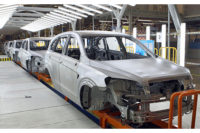Many manufacturers are just now beginning to focus on their aging workforces. In contrast, Hanover, Germany-based Continental AG has been concerned about this major demographic change for more than 30 years.
Back in the early 1980s, the company took part in its first initiative to help older workers. Called Age-Based Workplace Layout in Serial Tire Production, the initiative was part of the Humanization of the Working Life program overseen by the German federal government. Its purpose was two-fold: reduce workplace stress through technical and layout improvements, and implement organizational and individual measures to enable employees to continue working until they are older.
Continental achieved both goals at its participating facilities. The company installed new, computerized machines that improved production capacity, leading to higher output on standard and labor-intensive shifts. In addition, the proportion of tire assemblers aged 55 years and over rose from 6.2 to 27.6 percent.
Although the initiative ended in the mid-1980s, Continental maintained its practices and was able to stay ahead of the demographic curve for many years. Shortly into the 21st century, however, management knew it needed a better way to find the job best suited for each of its older workers.
“Our ergonomics project enables us to optimally adapt [jobs] to the people involved,” says Peter Dolfen, MD, head of corporate health, industrial hygiene, safety and security at Continental. “We improve production quality, protect the well-being of our employees and see to it that [they] have healthy working conditions through to retirement.”
Less Stress in the Workplace
In late 2004, the company formed a research group called Demographic Challenges for Factories (DCF). It consisted of 15 people with different positions, including the company physician and employees from human resources, production and industrial engineering.
One of the DCF’s main projects was the creation of the Stress Documentation System (SDS), which requires each workplace to undergo an extensive hazard assessment. Data obtained from the assessment determines whether the workplace is considered age-stable, conditionally age-stable or non-age-stable.
Under normal circumstances, employees of any age can continue to work in an age-stable workplace until age 65 (statutory retirement). Conditionally age-stable workplaces, in contrast, require some changes for older workers to continue working there. Workers in non-age-stable workplaces are at risk of adverse, long-term health effects and should be switched to another job before reaching retirement age.
By combing the first two categories, managers can determine the rate of age stability for a plant or the company as a whole. This rate represents the percentage of workplaces that are suitable for older employees.
Managers rely on hazard assessments to determine a workplace’s physical strain rate. This rate represents the number of physical hazards in a workplace, such as the frequency of lifting heavy loads using poor posture, lighting conditions, noise, vibration, air temperature and constant mental strain. To upgrade a workplace, managers implement large or small ergonomic changes as needed.
The initial use of SDS took place in early 2005 at the company’s Stöcken plant, which employed about 3,700 people. At the time, nearly 1,500 employees worked in production; the rest were in administration and R&D. The average age among production workers was 40.1 years. About 16 percent were aged 50 years or over, and more than 40 percent were aged 35 to 40 years. Most production workers were unskilled or semi-skilled, and less than 10 percent were women.
During this project, 250 production workplaces were evaluated. Only 30 percent proved to be age-stable and designed to accommodate older workers. However, another 40 percent could become age-stable through a layout redesign. Most of the other workspaces were considered non-age-stable.
Over the next two years, Continental expanded the use of SDS to other plants in Germany. By 2007, about 20 percent of the company’s production jobs in Germany were age-stable. Within three years, Continental had assessed the workplaces of 25,000 employees and made sure that 25 to 30 percent of the jobs at each plant were age-stable. This impressive achievement earned Continental a FOKUS 50plus Award from Apriori business solutions AG in the fall of 2010. The company was one of seven honorees.
At the event, Dolfen said that SDS makes workaday life easier for older colleagues at Continental, while noting that younger employees benefit from the system as well. He also promised that the company would continue to take steps to meet the demographic challenge of an aging workforce in Germany, throughout Europe and worldwide.
Early in 2011, the company began another pilot program related to workplaces. It involved the installation of a standard traffic light near a production workplace to visually indicate its level of age-stableness. A green light indicates the workplace is suitable for employees of any age. Yellow means that areas of the workplace need ergonomic improvement. Red means that the workplace is not suitable for older workers.
A decade after its introduction, SDS has proven to be a win-win for everyone in the company. Employees benefit because their workspaces are specifically designed to prevent premature physical wear down. The company benefits through lower operating expenses due to fewer occupational accidents and diseases.
SICK and Tired of Unsafe Presses
Tire manufacturing is a complex process that places high demands on tire-curing presses, which give car tires their final shape. It also presents an ongoing challenge regarding worker safety. This is because one worker is often responsible for operating several tire-curing presses simultaneously.
In the fall of 2013, SICK AG partnered with Continental to begin a pilot project to improve worker safety around dual tire-curing presses at 16 of Continental’s plants worldwide. The project’s other goals were to optimize worker ergonomics and machine flexibility, according to Timo Kuss, global project and plant engineering manager at Continental in Aachen, Germany.
Step one of the project required Continental to perform a comprehensive risk assessment on its tire-curing presses in several plants located around the world. After this, specialists from SICK Safety Services carried out an external risk assessment to provide Continental with a second opinion that verified its findings.
The two companies then created a comprehensive safety program, which took into account all the mechanical risks at the front, sides, rear and underneath the presses. Laser scanners were placed at the front of the presses—where the workers load and operate the machines—while physical guards were positioned underneath. Safety light curtains and safety doors or barriers with safety switches provide protection at the sides and rear.
Worker safety was very important to Continental, but so was worker productivity and machine flexibility. To achieve the latter goal required that all safety components have short shutdown times.
The system SICK designed for the project is known as Sim-4-Safety, which features an S3000 laser scanner and Flexi Soft controller. It is able to simultaneously monitor up to four protective fields on the tire-curing press. This capability enables it to monitor the press motion and loading arm movements on two presses working alongside each other. Equally important, the system provides worker protection without having to shut down a neighboring machine when a protective field is violated.
Hand in Hand: Ergonomics and Efficiency
Early last year, the company decided to join the ergonomics project with Continental Business Systems (CBS), its lean manufacturing division. The goal is to increase productivity and worker efficiency. To achieve this, every job action is based on ergonomic work movements.
“We [want to] optimize work processes by cutting out anything that wastes time, effort or cost—such as unnecessary movements or unsuitable process sequences,” explains Oliver Prause, Ph.D., head of CBS. “This [will help] us achieve the most efficient results for our customers and design work sequences with minimum interruptions for our employees.”
He says all Continental employees are, and should be, challenged by their jobs. But, they should never be doing things that cause excessive strain—regardless of age or sex. Prause believes that combining ergonomics with CBS makes it possible for Continental to achieve “a marriage of perfect, technical work processes and age-stable, ergonomic working conditions for the employee.”
The company recently implemented this joint approach at its plant in Bebra, Germany, to see if it would improve worker efficiency when assembling compressors. The assembly process requires workers to alternate between standing and sitting, but does allow them to adjust the height of the workstation for each activity.
It also requires workers to rotate between workstations every few hours in a fixed rhythm. This prevents work from becoming monotonous, and it ensures that all workers learn all the assembly steps so they can be assigned to any job as needed.
Over the last decade, the age and years of company service of the average Continental worker in Germany have continued to climb. As of January 2015, those respective numbers are 43.2 and 14.8.
This trend confirms what government statistics predict: that, by 2021, the number of production employees in the 55-to-65 age bracket in Germany will be near 35 percent, compared to 8 percent in 2005 and 13 percent in 2011.
Nevertheless, Klaus-Dieter Wendt, head of ergonomics for Continental, says the company is confident it can meet this challenge. The reason is SDS. By relying on its ergonomics data, Continental is on target to have its workplaces demographically align with 50 percent of its workforce by 2020.





